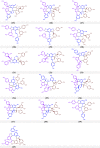Phytochemical and pharmacological profile of genus shorea: A review of the recent literature
- PMID: 38293342
- PMCID: PMC10827409
- DOI: 10.1016/j.heliyon.2023.e23649
Phytochemical and pharmacological profile of genus shorea: A review of the recent literature
Abstract
In tropical Southeast Asia, Shorea is the most economically important tree and the largest genus in the Dipterocarpaceae family. It comprises about 150-200 species, of which majority are distributed in Malaysia, with others found in Sumatra and Borneo (Kalimantan) in Indonesia. Research on the chemical constituents of Shorea plants has been ongoing for many years. To date, a total of 113 different compounds, including 83 stilbenes and their resveratrol oligomers, 18 triterpenes/terpenoids, 7 coumarins 3 flavonoids and 2 steroids have been isolated and successfully elucidated from 26 different species of this genus. The diversity of the stilbene resveratrol oligomers in the Shorea genus is primarily due to the difference in the amount of resveratrol constituent units, which include dimers, trimers and tetramers. In addition to the species' traditional usage in the treatment of illnesses, such as diarrhea, toothaches, skin diseases, ear troubles and wounds, the extracts and secondary metabolite compounds isolated from various parts of the plant species are known to have a very potent antioxidant, antimicrobial, anticancer, anti-diabetic, anti-obesity, antiulcer, hepatoprotective and nephroprotective activities. This review aims to summarize the most recent research made from 1999 to date on the secondary metabolite compounds isolated from different species of genus Shorea, as well as the bioactivity (in vitro and in vivo) of the crude extracts and the isolated secondary metabolite compounds.
Keywords: Coumarins; Dipterocarpaceae; Oligostibene; Shorea; Triterpenoids.
© 2023 Published by Elsevier Ltd.
Conflict of interest statement
The authors declare that they have no known competing financial interests or personal relationships that could have appeared to influence the work reported in this paper.
Figures



















References
-
- Lewington A. Traffic International; Cambridge, UK: 1993. Medicinal Plant and Plant Extracts: a Review of Their Importation into Europe.
-
- Akerele Olayiwola, Heywood Vernon H., Synge Hugh, World Health Organization . Cambridge University. Press; March 1988. World Conservation Union. et al. 1991. The Conservation of medicinal plants: proceedings of an international consultation; pp. 21–27.https://apps.who.int/iris/handle/10665/36877
-
- Citarasu T. In: Infectious Disease in Aquaculture. Austin B., editor. Woodhead Publishing; Cambridge, UK: 2012. Natural antimicrobial compounds for use in aquaculture; pp. 419–456.
-
- Sultanbawa M.U.S., Surendrakumar S., Bladon P. Distichol an antibacterial polyphenol from Shorea disticha. Phytochemistry. 1987;26:799–801. doi: 10.1016/S0031-9422(00)84790-1. - DOI
-
- Ashton P.S. In: van Steenis C.G.G.J., editor. vol. 9. 1982. Dipterocarpaceae; pp. 237–552. (Flora Malesiana I).
Publication types
LinkOut - more resources
Full Text Sources

